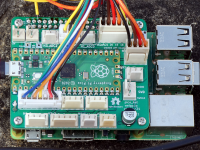Pico HAT

Pico_Hat: Connect your Raspi with the Pico through I²C and get plenty of headers with flexible inputs
Some infos
The Pico connects to all the sensors and actuators and can act in `Real Time`. The Raspi can do the rest (Wifi, Webserver, MQTT, Display ...). The Pico is an I²C slave to the Raspi and the Raspi sends commands with a Python script to the Pico. An Arduino program on the Pico answers with sensor data or by switching an actuator.
As the Arduino IDE runs on a Raspi, both device (Raspi and Pico) can be reprogrammed via VNC from any computer, and I find this pretty amazing :).
Features
+ The Raspi is connected through I²C with the Pico. Serial is prepared if needed (by adding 2 0Ω resistors).
+ The Pico can be powered over USB (recommended if you want to reprogram it via Arduino IDE and VNC) or through the Raspi (5V).
+ All GPIOs have the possibility to add a voltage divider to reduce the input voltage (e.g. 5V to 3.3V), or to add an external pull-down resistor.
+ All headers have beneath a ground pin, one or two power pins (3.3V or 5V; `H2` headers: 3.3V and 5V).
+ Additionally we get a RESET-button, an `SWD` header, 2 power header (3.3V and 5V), 2 Ground pins, an an 3V3_EN and ADC_VREF pins.
+ The circuit is designed with KiCAD and is open hardware..
All infos on: http://www.weigu.lu/microcontroller/pico_hat/index.html
All code and files on github: https://github.com/weigu1/Pico_HAT
The Pico connects to all the sensors and actuators and can act in `Real Time`. The Raspi can do the rest (Wifi, Webserver, MQTT, Display ...). The Pico is an I²C slave to the Raspi and the Raspi sends commands with a Python script to the Pico. An Arduino program on the Pico answers with sensor data or by switching an actuator.
As the Arduino IDE runs on a Raspi, both device (Raspi and Pico) can be reprogrammed via VNC from any computer, and I find this pretty amazing :).
Features
+ The Raspi is connected through I²C with the Pico. Serial is prepared if needed (by adding 2 0Ω resistors).
+ The Pico can be powered over USB (recommended if you want to reprogram it via Arduino IDE and VNC) or through the Raspi (5V).
+ All GPIOs have the possibility to add a voltage divider to reduce the input voltage (e.g. 5V to 3.3V), or to add an external pull-down resistor.
+ All headers have beneath a ground pin, one or two power pins (3.3V or 5V; `H2` headers: 3.3V and 5V).
+ Additionally we get a RESET-button, an `SWD` header, 2 power header (3.3V and 5V), 2 Ground pins, an an 3V3_EN and ADC_VREF pins.
+ The circuit is designed with KiCAD and is open hardware..
All infos on: http://www.weigu.lu/microcontroller/pico_hat/index.html
All code and files on github: https://github.com/weigu1/Pico_HAT



Discussie (0 opmerking(en))